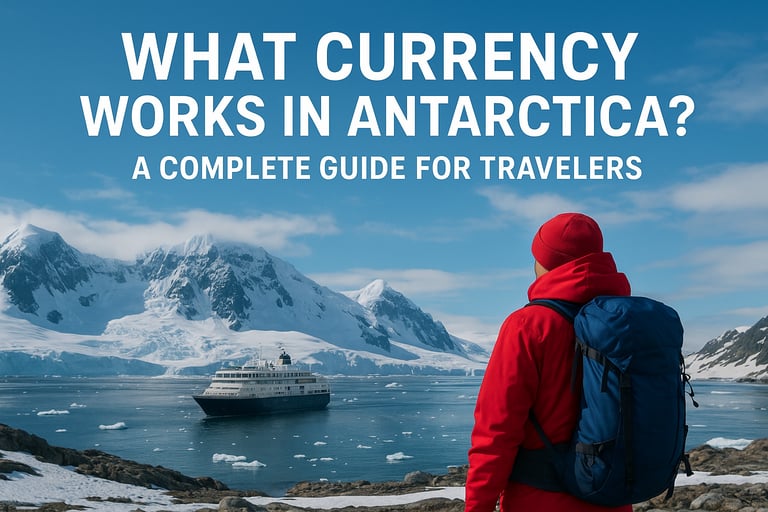What Currency Works in Antarctica? A Complete Guide for Travelers
Planning a trip to Antarctica? Learn everything you need to know about the currencies accepted, how to pay at research stations and expedition cruises, and essential tips for a smooth financial experience in the frozen continent. Travel Explorer brings you the ultimate guide.
ANTARCTICA
10/5/20254 min read
Introduction
Antarctica, the last great wilderness on Earth, is a land of glaciers, icebergs, and breathtaking wildlife. While it captivates adventurers and researchers alike, traveling to this extreme environment comes with unique challenges—including financial ones. Unlike any other continent, Antarctica does not have an official government, native population, or central bank. So, what currency do you use when you visit the frozen continent?
In this guide, we explore the practicalities of money in Antarctica, from research stations to expedition cruises, and offer tips for travelers to manage their finances while exploring the icy frontier.
No National Currency in Antarctica
The first thing to understand is that Antarctica has no national currency. Since the continent is governed by the Antarctic Treaty System and has no permanent residents, there is no legal tender that is universally accepted. This unique status makes planning finances for a trip here unlike any other destination.
Instead, currencies are linked to the countries operating research stations or the expedition companies that take tourists to Antarctica. Visitors must plan in advance to ensure they have access to acceptable forms of payment.
The Antarctic Dollar – A Collector’s Curiosity
While there is no official currency, the Antarctic Dollar exists as a novelty. Produced for collectors and tourists, it is not considered legal tender and cannot be used for purchases.
The Antarctic Dollar is pegged to the US Dollar, with denominations similar to traditional currencies. Visitors sometimes buy them as souvenirs, but it has no practical function for transactions. Essentially, it’s a symbolic way to commemorate a visit to one of the most remote places on Earth.
Currency at Research Stations
Antarctica is home to over 70 research stations operated by countries including the United States, New Zealand, Russia, Australia, Argentina, and the United Kingdom. Currency usage depends on the nationality of the station and its personnel.
McMurdo Station – United States
Currency: US Dollars
Payment: Mostly cashless; some facilities accept credit cards
Context: This is the largest Antarctic station and serves as a hub for scientific research and logistics. Personal purchases inside the station, such as small groceries, snacks, or souvenirs, are usually priced in US Dollars.
Scott Base – New Zealand
Currency: New Zealand Dollars; US Dollars also accepted
Payment: Cashless transactions via internal accounts
Context: Managed by New Zealand, Scott Base accommodates scientists and support staff. While visitors are rare, any purchases or onboard transactions are generally in NZ Dollars.
Other Stations
Stations run by Argentina, Russia, or the UK use their home country’s currency for internal transactions.
Important: These currencies are mostly for internal use; outside visitors cannot access local banking or ATMs within research stations.
Expedition Cruises and Currency
Tourism in Antarctica is primarily conducted via expedition cruises. Departure points are usually in Ushuaia, Argentina, or Punta Arenas, Chile.
Here’s what travelers should know about currency on these cruises:
Common Currencies
US Dollars: Widely accepted onboard most international cruise operators.
Euros: Accepted on some European-operated expeditions.
Credit/Debit Cards: Visa and MasterCard are universally accepted for onboard expenses.
Payment System
Most cruises operate a cashless system. Travelers maintain an onboard account where all charges—souvenirs, drinks, optional excursions—are added.
Payments are settled at the end of the expedition using your preferred card or pre-arranged currency.
Tipping is recommended, typically ranging from $10–$20 USD per person per day, depending on the cruise.
Currency in Ushuaia and Punta Arenas
Since most Antarctic trips start from South America, it’s essential to understand the currency situation in gateway cities:
Ushuaia, Argentina
Currency: Argentine Peso (ARS)
Notes: US Dollars are often accepted in hotels and tourist shops.
Advice: Carry some ARS for local purchases, taxis, or small services.
Punta Arenas, Chile
Currency: Chilean Peso (CLP)
Notes: US Dollars may be accepted in tourist areas.
Advice: Cash is useful for smaller transactions outside of the main hotels and tour offices.
Credit Cards, ATMs, and Digital Payments
Given the extreme environment of Antarctica:
ATMs: Nonexistent on the continent itself. Travelers should withdraw cash before departure.
Credit Cards: Accepted on expedition ships and most gateway cities.
Digital Payments: Not widely available in Antarctica, so traditional payment methods remain essential.
Practical Tips for Travelers
1. Bring Multiple Payment Options
Always carry both cash and credit cards. This ensures you’re prepared for emergencies or places where card payments may not be possible.
2. Inform Your Bank
Notify your bank about your travel plans to prevent your card from being flagged for unusual activity, especially when transactions are made from a remote location.
3. Currency Exchange
Exchange rates fluctuate, so plan ahead. Converting local currency in your departure city is often cheaper than relying on international exchanges mid-journey.
4. Budget Wisely
Traveling to Antarctica is expensive. A typical expedition can cost $5,000–$15,000 USD per person. Include extra funds for tipping, onboard purchases, souvenirs, and optional excursions.
Why Understanding Currency Matters
Traveling to Antarctica isn’t just about breathtaking views or wildlife encounters; it’s also about logistics and preparation. Misunderstanding how money works in the region can lead to unnecessary stress.
Since Antarctica has no banks, ATMs, or widespread currency exchange, travelers must be fully prepared with the right forms of payment. Knowing which currencies are accepted at stations, expedition cruises, and gateway cities ensures a smooth, stress-free adventure.
Additional Tips for Travelers
Keep Receipts: Record all onboard expenses for easy reconciliation at the end of your trip.
Currency Backup: Consider carrying a small reserve in US Dollars for emergencies.
No Need for Local Banking: Unlike other destinations, there’s no requirement to open local accounts or carry foreign currency beyond what your cruise or research station accepts.
Summary
Although Antarctica has no official currency or central bank, practical solutions exist for travelers:
Research Stations: Transactions use the station’s home country currency.
Expedition Cruises: Primarily US Dollars, sometimes Euros, with cashless accounts.
Gateway Cities: Ushuaia and Punta Arenas support local currency (ARS or CLP) and US Dollars for tourist transactions.
Credit Cards: Essential for almost all payments on cruises and in gateway cities.
Cash: Useful for smaller expenses and tipping.
By understanding how money works in Antarctica, travelers can focus on the adventure, from watching penguins to exploring the frozen landscape, without worrying about finances.
Conclusion
Antarctica is a once-in-a-lifetime destination, but its lack of a native currency and financial infrastructure makes preparation essential. While the Antarctic Dollar exists as a fun souvenir, real-world transactions rely on US Dollars, Euros, or the currency of research station countries. Travelers should ensure they have access to credit cards, carry some local cash in gateway cities, and plan their budget carefully for a seamless experience in the frozen continent.
With these insights, your Antarctic adventure will be financially smooth, allowing you to focus on the stunning landscapes and unique wildlife that make this continent one of the most extraordinary places on Earth.
Reference: Travel Explorer – Your guide to planning trips in remote and extreme destinations


© 2025. All rights reserved.


